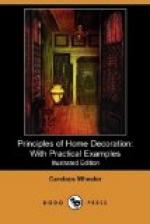It may be well to reiterate the fact that the predominant use of each room in a house gives the clew to the best rules of treatment in decoration and furniture. For instance, the hall, being an intermediate space between in and out of doors, should be coloured and furnished in direct reference to this, and to its common use as a thoroughfare by all members of the family. It is not a place of prolonged occupation, and may therefore properly be without the luxury and ease of lounges and lounging-chairs. But as long as it serves both as entrance-room to the house and for carrying the stairways to the upper floors, it should be treated in such a way as to lead up to and prepare the mind for whatever of inner luxury there may be in the house. At the same time it should preserve something of the simplicity and freedom from all attempt at effect which belong to out-of-door life. The difference between its decoration and furniture and that of other divisions of the house should be principally in surface, and not in colour. Difference of surface is secured by the use of materials which are permanent and durable in effect, such as wood, plaster, and leather. These may all be coloured without injury to their impression of permanency, although it is generally preferable to take advantage of indigenous or “inherent colour” like the natural yellows and russets of wood and leather. When these are used for both walls and ceiling, it will be found that, to give the necessary variation, and prevent an impression of monotony and dulness, some tint must be added in the ornament of the surface, which could be gained by a forcible deepening or variation of the general tone, like a deep golden brown, which is the lowest tone of the scale of yellow, or a red which would be only a variant of the prevailing tint. The introduction of an opposing or contrasting tint, like pale blue in small masses as compared with the general tint, even if it is in so small a space as that of a water-colour on the wall, adds the necessary contrast, and enlivens and invigorates a harmony.




